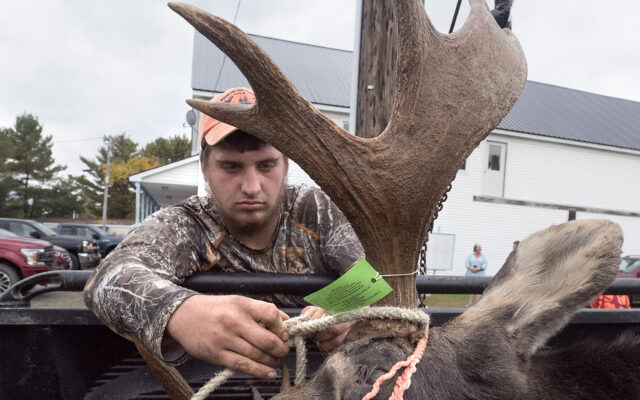
Moose season begins Monday
AUGUSTA — On Monday, Sept. 26, over 1,000 moose hunters are expected to enter the Maine woods pursuing Maine’s most majestic mammal. This is the 42nd year of Maine’s modern moose hunt, a hunt which resumed in 1980 after being closed since 1936.
This year, there are 4,080 permits that were issued to hunt moose in Maine. This was an increase of 50 permits from last year, it’s the second highest total ever issued, and the most permits since 2013. Over 69,000 people applied for the opportunity to hunt moose in Maine, including nearly 25,000 nonresidents.
Regulated hunting seasons are how the department manages Maine’s moose population. The number of permits issued for each moose hunting district varies depending on moose population density in the district and publicly derived management goals that balance the opportunities to view moose and hunt moose, and for road safety in some areas.
“Maine’s Moose hunt is well-known as the hunt of a lifetime,” said MDFIW Commissioner Judy Camuso. “The moose hunt attracts hunters from all over the United States and beyond. Maine’s moose hunt is one of the many reasons Maine is so well-known as an outdoor recreation destination.”
The moose season is comprised of multiple week-long seasons and one month-long season. There are 1,050 permits for the opening week in the far northern and eastern areas of the state Sept. 26 through Oct. 1. An additional 1,580 permits are for moose hunting Oct. 10-15. There are 860 permits for moose hunting Oct. 24-29, and 40 permits for moose hunting in west-central Maine Oct. 29 through Nov. 26. In Zone 4 in northern Somerset and Piscataquis counties, there also is an adaptive moose hunt designed to lower the moose population to see if lower moose densities will lower winter tick densities. Winters ticks are the primary killer of moose calves. The weeks and number of permits for this hunt is as follows: Oct. 17-22, 200 cow permits; Oct. 24–29, 150 cow permits; and Oct. 31 to Nov. 5, 200 cow permits.
Last year, 65 percent of all moose hunters were successful. The success rate for moose hunters is in stark contrast to bear, turkey or deer hunting, where success rates range historically from 18 to 30 percent.
All successful moose hunters are required to register their moose at the nearest tagging station. At these stations, IFW wildlife biologists collect data that provides insight into moose population health. A tooth is removed in order to determine the age of the moose. Antler spread (width) is measured on bulls. Ticks are counted on four different areas of the moose to compare numbers to years past. In later weeks, moose hunters who shoot a female moose are required to bring the ovaries, which are later examined to determine reproductive success.
This biological data is combined with data from the moose GPS collar study, as well as the aerial moose population and composition surveys to give biologists a clearer picture of the health and status of Maine’s moose herd. Over the past nine years, the department has captured, collared and tracked over 750 moose, providing unique insight into moose survival and reproduction.
This is the second year of the Adaptive Moose Hunt which is determining if lowering the moose population density can lower the abundance and impact of winter tick. The study began in 2019 and is expected to run through at least 2025, and focuses on a 2,000 square mile management zone in the northwestern part of the state (Zone 4) has been divided into two similarly sized sections.
In phase one, aerial helicopter surveys assessed current population size and composition. Sixty moose calves (30 in each section of the unit) were captured and fitted with GPS collars to monitor their survival.
In phase two, MDIFW increased the number of hunting permits in the western half of zone 4 (6 percent of Maine’s core moose range) in fall 2021 to reduce the moose population density. In the eastern half of zone 4 as well as all other zones open to moose hunting, moose permits will remain at normal levels. Biologists will collect several data points from all moose harvested in either subsection of Zone 4, including canine teeth (for aging), antler spreads, winter tick counts, corpora lutea, and carcass weights. In addition, biologists will continue aerial surveys and monitoring calves with GPS collars.
If it is determined that increased harvest leads to lower winter tick levels and healthier moose, that information may allow for increased permit allocations in other areas of the state. Learn more about MDIFW’s Adaptive Management Study and how winter tick is impacting moose.